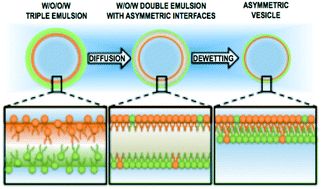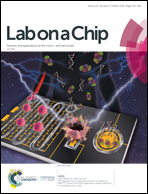Single-step assembly of asymmetric vesicles
Abstract
Asymmetric vesicles are membranes in which amphiphiles are asymmetrically distributed between each membrane leaflet. This asymmetry dictates chemical and physical properties of these vesicles, enabling their use as more realistic models of biological cell membranes, which also are asymmetric, and improves their potential for drug delivery and cosmetic applications. However, their fabrication is difficult as the self-assembly of amphiphiles always leads to symmetric vesicles. Here, we report the use of water-in-oil-in-oil-in-water triple emulsion drops to direct the assembly of the two leaflets to form asymmetric vesicles. Different compositions of amphiphiles are dissolved in each of the two oil shells of the triple emulsion; the amphiphiles diffuse to the interfaces and adsorb differentially at each of the two oil/water interfaces of the triple emulsion. These middle oil phases dewet from the innermost water cores of the triple emulsion drops, leading to the formation of membranes with degrees of asymmetry up to 70%. The triple emulsion drops are fabricated using capillary microfluidics, enabling production of highly monodisperse drops at rates as high as 300 Hz. Vesicles produced by this method can very efficiently encapsulate many different ingredients; this further enhances the utility of asymmetric vesicles as artificial cells, bioreactors and delivery vehicles.



 Please wait while we load your content...
Please wait while we load your content...